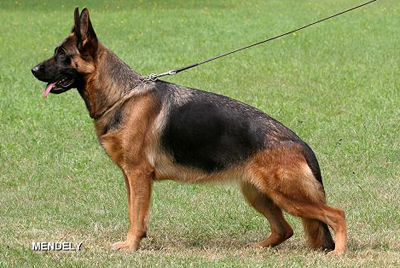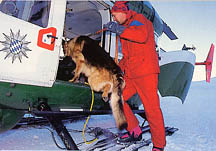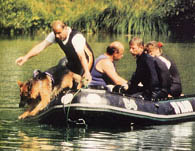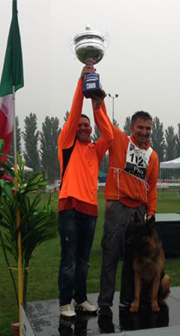THE SELECTION OF THE GERMAN SHEPHERD
Selecting means to isolate, in the evolutive process, those constant and genetically transmittable characteristics for the progeny.


The selection may be:
The isolation of genetically transmittable and desirable characteristics are performed by man. With the artificial selection (which must and cannot be in contrast with what would happen in nature), man aims to accentuate morphological or character qualities with the goal of being able to fulfill a more efficient function.
That which we term briefly as Selection would in reality be termed "morphological - functional – character testing".
Serious breeders aim in this manner for that ideal dog that, aside from being morphologically desirable, must also have a stable character and be suitable in performing all those activities that belong to the breed.
The German Shepherds gifted with such desirable morpho-character traits thereby making them good reproducers can then be selected with great care by the owner or breeder with enormous sacrifices of their time and money.
In order to pass the Selection a dog must:
-have at least one working title that consists in training the dog on a level equal to the duties of a police dog, teaching it defence, obedience and tracking exercises.
-pass the resistance tests (that consists in running 20 KM. with the dog beside its master who usually accompany it on a bicycle).
-have passed the test on the absence of hip dysplasia.
To verify that the dog is indifferent to gunshots (a test that in German Shepherd dog shows is repeated throughout the exbitions).
The Selection test is carried out in this manner:
The gunshot indifference test, in which the dog displays having nerves of steel and a good equilibrium in remaining indifferent (at the impact provoked by the gunshot) is followed by the test on indifference to strangers.
After these tests, the defense exercises follow in which the dog must sustain two types of attack, that is, unexpected and launched attacks.
In the unexpected attack, the assistant (who represents the wrong-doer) wearing a protective sleeve jumps out of his hiding place with a cudgel, threatening the master.
During the time when the assistant is hidden, the dog should be walking tranquilly beside its master.
In succession, as the dog sees the assistant leave his hiding place with the cudgel, it launches itself against him biting the protective sleeve solidly and not letting itself be intimidated by the threats or the two blows inflicted upon it by the assistant.
The dog must therefore demonstrate its courage and readiness in defending its master who observes the scene. Once the exercise is over (the moment the dog succeeds in stopping the wrong-doer), the master orders the dog to "let go" of the protective sleeve.
Obeying the command "let go", the dog continues to keep the wrong-doer under surveillance until the moment when its master approaches and puts himself to the right side of his dog.
In succession, the master takes the dog by the collar preparing it for the position of sustaining the "launched" attack test.
The launched attack consists in taking the dog to the far end of the field in which the test takes place, then making the dog "launch" into a run towards the assistant.
The dog, at impact, must solidly bite the protective sleeve, after which, the assistant drags it, this action is defined as "transport".
At this point, the dog can affirm whether or not it has passed the character tests, and so only the morphological tests, attended by the dog show judge, remains.
The dog show judge sees to examining all the parts of the dog from the teeth which have to be healthy, strong and complete, to the measurements of height, diameters, weight, etc.
The dog show judge must, in the end, consider the most important qualities and defects of the dog, judge the pedigree and be able to express advice and suggestions regarding the reproduction of that model.
It is obvious that a selecting judge must have good knowledge of the bloodlines and a concrete experience in breeding.
The Selection test is a test that aims to have that which can be defined as a complete dog, a 360-degrees dog, but the test in itself does not guarantee good reproduction if it is not managed by conscientious and healthy breeding.
The Selection test in Italy is still little used even if it is obligatory for all the dogs of beauty to undergo the test in order to be able to rightly participate in the shows and, in case meriting them, pursue the most important titles.
During the Selection test, the measurement of the height of the withers is always a good subject of controversies because the Standard speaks clearly but is a cephalous enough to negatively judge such a complex machine like a dog, advising against reproduction for example in cases where a dog exceeds just a little above the size set by the standard, but boasts of countless other qualities in reproduction.
It would rather be like having to choose between perfect mediocrity and a capricious subject that is superior to the norm, keeping undoubtedly in mind the handicap!
nother problem regarding the measurement of the withers consists in the fact that it is very difficult, if not impossible, to determine the measurement with precision since it can be influenced by the dog’s incorrect posture or by the metacarpi being excessively or poorly flexible, and above all, by the ability of the dog’s handler in making the dog seem more "as it should be".
In Italy, in contrast with Germany (where the selecting judge is the same for the character and morphological aspects), the judge is not the only one because: the morphological judge and the character judge are expressed by two different judges.
In Germany, as alternative to the Working Titles, the dog can undergo the test of sheep-herding, that is, HGH (in Italy, it is not possible).
The German Shepherds can schematically be subdivided in five groups:

-selected dogs (as clearly explained beforehand, respecting the standard on morphological and character levels), in order to receive the "Selection", must pass some training tests aside from being perfectly in line with the morphological parameters required.
This group of "real reproducers" represent only 1 % of the population. It has been observed that returning dogs in the shows, besides reaching the class of adult dogs participate and produce the best results.
-sons/daughters of selected dogs (deserving aspirants to being show dogs, but have to be selected as soon as possible in their turn) belong to the 4% of the German Shepherd population.
In order to understand better these first two sectors, we can affirm that the "Breeders" (with a capital B) work throughout the year in selecting their best dogs and presenting them to the Enci shows and in the special SAS meetings.
The most important contests of the year for a breeder are the SAS Italian Breeding Championship and the SV World Championship that is held in Germany.
Both championships are held once a year.
During the very frequent shows throughout the contest seasons, which is from March to October, the tests which the dogs must undergo are morphological tests.
In the Championships an attack test is also foreseen for adult dogs.
The dog is initially judged at rest before being judged in motion within the circle of its own class (divided by sex and age).
During the motion test, the dog is inserted in its own class or category with a temporary classification that the judge can update continuously as the competition gets underway.
In the motion test, the subjects execute gaits and trots which must be well-balanced, smooth and close to the ground, the latter being maintained throughout.
In a second subgroup (more numerous than the first) belong the dogs that are bred with very little zoo technical conscience.
In third subgroup (very numerous) belong the majority of "German Shepherds" completely atypical since they are bred without any scruples and knowledge of the most banal and elementary rules of breeding by pseudo-breeders who do not aim for the selection of the breed but consider only the economic side.
It is important and fundamental to understand that there are a lot of ways to do something: good, bad, superficially or conscientiously and with scruples.
It must be said that the activity of breeding does not offer the breeder the possibility of making his own misdeeds disappear forever and leave unchanged the nature of things, but rather obligates those small seeds to go about the world, which zoo technically, in the end, will surely create a deterioration in the canine patrimony to the disadvantage of other breeders who every day make sure that the subjects they produce conform to the true nature of the German Shepherd, which is a complete dog both morphologically and characteristically and, in this manner, a multi-functional dog.
In this group belong only 0, 25% of German Shepherds.
Such types of activity consist in developing and sharpening the character traits that substantially the dog must already have by way of the selection.
The working tests consist of the same tests that the selected German Shepherd must have performed in order to reach the most important titles, but with the working dog, the real objective is to perform such tests to perfection in order to obtain the maximum of total points.
In preparing the dog for the shows, at a certain point in its career it must be certified that even characteristically, the dog is doted with the tendencies that belong to its breed.
On the contrary, it happens that in the working dog the beauty "aspect" is not as important nor as imposed with such inevitability as on the contrary the working "aspect" is imposed to the selected German Shepherd who can worthily boast of having more equilibrium and wholeness regarding its character and the coat that covers it.
For a working dog, the enunciations of the defects or the qualities during the morphological judgment can create real embarrassment because usually these dogs have very little morphological qualities and abound instead with defects since the typification is their Achilles’ heel.






The selection may be:
-natural:
onsists of the natural spontaneous process with which those determined characteristics are transmitted to the progeny making it easier and safer for them to survive in an environment. It has been observed that when it happens in nature beings that survive with such characteristics (suitable for the improvement of survival) often perish before transmitting them to the progeny. This image represents best the concept of natural selection.-artificial:
when is made by man.The isolation of genetically transmittable and desirable characteristics are performed by man. With the artificial selection (which must and cannot be in contrast with what would happen in nature), man aims to accentuate morphological or character qualities with the goal of being able to fulfill a more efficient function.
That which we term briefly as Selection would in reality be termed "morphological - functional – character testing".
Serious breeders aim in this manner for that ideal dog that, aside from being morphologically desirable, must also have a stable character and be suitable in performing all those activities that belong to the breed.
The German Shepherds gifted with such desirable morpho-character traits thereby making them good reproducers can then be selected with great care by the owner or breeder with enormous sacrifices of their time and money.
In order to pass the Selection a dog must:
-have at least one working title that consists in training the dog on a level equal to the duties of a police dog, teaching it defence, obedience and tracking exercises.
-pass the resistance tests (that consists in running 20 KM. with the dog beside its master who usually accompany it on a bicycle).
-have passed the test on the absence of hip dysplasia.
To verify that the dog is indifferent to gunshots (a test that in German Shepherd dog shows is repeated throughout the exbitions).
The Selection test is carried out in this manner:
The gunshot indifference test, in which the dog displays having nerves of steel and a good equilibrium in remaining indifferent (at the impact provoked by the gunshot) is followed by the test on indifference to strangers.
After these tests, the defense exercises follow in which the dog must sustain two types of attack, that is, unexpected and launched attacks.
In the unexpected attack, the assistant (who represents the wrong-doer) wearing a protective sleeve jumps out of his hiding place with a cudgel, threatening the master.
During the time when the assistant is hidden, the dog should be walking tranquilly beside its master.
In succession, as the dog sees the assistant leave his hiding place with the cudgel, it launches itself against him biting the protective sleeve solidly and not letting itself be intimidated by the threats or the two blows inflicted upon it by the assistant.
The dog must therefore demonstrate its courage and readiness in defending its master who observes the scene. Once the exercise is over (the moment the dog succeeds in stopping the wrong-doer), the master orders the dog to "let go" of the protective sleeve.
Obeying the command "let go", the dog continues to keep the wrong-doer under surveillance until the moment when its master approaches and puts himself to the right side of his dog.
In succession, the master takes the dog by the collar preparing it for the position of sustaining the "launched" attack test.
The launched attack consists in taking the dog to the far end of the field in which the test takes place, then making the dog "launch" into a run towards the assistant.
The dog, at impact, must solidly bite the protective sleeve, after which, the assistant drags it, this action is defined as "transport".
At this point, the dog can affirm whether or not it has passed the character tests, and so only the morphological tests, attended by the dog show judge, remains.
The dog show judge sees to examining all the parts of the dog from the teeth which have to be healthy, strong and complete, to the measurements of height, diameters, weight, etc.
The dog show judge must, in the end, consider the most important qualities and defects of the dog, judge the pedigree and be able to express advice and suggestions regarding the reproduction of that model.
It is obvious that a selecting judge must have good knowledge of the bloodlines and a concrete experience in breeding.
The Selection test is a test that aims to have that which can be defined as a complete dog, a 360-degrees dog, but the test in itself does not guarantee good reproduction if it is not managed by conscientious and healthy breeding.
The Selection test in Italy is still little used even if it is obligatory for all the dogs of beauty to undergo the test in order to be able to rightly participate in the shows and, in case meriting them, pursue the most important titles.
During the Selection test, the measurement of the height of the withers is always a good subject of controversies because the Standard speaks clearly but is a cephalous enough to negatively judge such a complex machine like a dog, advising against reproduction for example in cases where a dog exceeds just a little above the size set by the standard, but boasts of countless other qualities in reproduction.
It would rather be like having to choose between perfect mediocrity and a capricious subject that is superior to the norm, keeping undoubtedly in mind the handicap!
nother problem regarding the measurement of the withers consists in the fact that it is very difficult, if not impossible, to determine the measurement with precision since it can be influenced by the dog’s incorrect posture or by the metacarpi being excessively or poorly flexible, and above all, by the ability of the dog’s handler in making the dog seem more "as it should be".
In Italy, in contrast with Germany (where the selecting judge is the same for the character and morphological aspects), the judge is not the only one because: the morphological judge and the character judge are expressed by two different judges.
In Germany, as alternative to the Working Titles, the dog can undergo the test of sheep-herding, that is, HGH (in Italy, it is not possible).
The German Shepherds can schematically be subdivided in five groups:

-selected dogs (as clearly explained beforehand, respecting the standard on morphological and character levels), in order to receive the "Selection", must pass some training tests aside from being perfectly in line with the morphological parameters required.
This group of "real reproducers" represent only 1 % of the population. It has been observed that returning dogs in the shows, besides reaching the class of adult dogs participate and produce the best results.
-sons/daughters of selected dogs (deserving aspirants to being show dogs, but have to be selected as soon as possible in their turn) belong to the 4% of the German Shepherd population.
In order to understand better these first two sectors, we can affirm that the "Breeders" (with a capital B) work throughout the year in selecting their best dogs and presenting them to the Enci shows and in the special SAS meetings.
The most important contests of the year for a breeder are the SAS Italian Breeding Championship and the SV World Championship that is held in Germany.
Both championships are held once a year.
During the very frequent shows throughout the contest seasons, which is from March to October, the tests which the dogs must undergo are morphological tests.
In the Championships an attack test is also foreseen for adult dogs.
The dog is initially judged at rest before being judged in motion within the circle of its own class (divided by sex and age).
During the motion test, the dog is inserted in its own class or category with a temporary classification that the judge can update continuously as the competition gets underway.
In the motion test, the subjects execute gaits and trots which must be well-balanced, smooth and close to the ground, the latter being maintained throughout.
family dogs
represent more than 90 % of the population. In a first subgroup (very few), real beauties, that make mistakes and are unfortunately wrongly dispatched, can be included.In a second subgroup (more numerous than the first) belong the dogs that are bred with very little zoo technical conscience.
In third subgroup (very numerous) belong the majority of "German Shepherds" completely atypical since they are bred without any scruples and knowledge of the most banal and elementary rules of breeding by pseudo-breeders who do not aim for the selection of the breed but consider only the economic side.
It is important and fundamental to understand that there are a lot of ways to do something: good, bad, superficially or conscientiously and with scruples.
It must be said that the activity of breeding does not offer the breeder the possibility of making his own misdeeds disappear forever and leave unchanged the nature of things, but rather obligates those small seeds to go about the world, which zoo technically, in the end, will surely create a deterioration in the canine patrimony to the disadvantage of other breeders who every day make sure that the subjects they produce conform to the true nature of the German Shepherd, which is a complete dog both morphologically and characteristically and, in this manner, a multi-functional dog.
working dogs
(represented by dogs that, from a morphological point of view, often have serious defects), it is logical that in working too doggedly to select one single aspect, the rest can be neglected. Dogs that generally belong to this group can have titles affirming that they can perform true cyno-athletic activities.In this group belong only 0, 25% of German Shepherds.
Such types of activity consist in developing and sharpening the character traits that substantially the dog must already have by way of the selection.
The working tests consist of the same tests that the selected German Shepherd must have performed in order to reach the most important titles, but with the working dog, the real objective is to perform such tests to perfection in order to obtain the maximum of total points.
In preparing the dog for the shows, at a certain point in its career it must be certified that even characteristically, the dog is doted with the tendencies that belong to its breed.
On the contrary, it happens that in the working dog the beauty "aspect" is not as important nor as imposed with such inevitability as on the contrary the working "aspect" is imposed to the selected German Shepherd who can worthily boast of having more equilibrium and wholeness regarding its character and the coat that covers it.
For a working dog, the enunciations of the defects or the qualities during the morphological judgment can create real embarrassment because usually these dogs have very little morphological qualities and abound instead with defects since the typification is their Achilles’ heel.

service dogs
(represented by 0, 5% of German Shepherds) are the dogs of the police, the carabinieri, the guardia di finanza, anti-rebel groups, narcotic squads, anti-bombing squads, civil protection with anti-avalanches, rubble-searching dogs, dogs for the blind, dogs tracking people, sheep dogs and last but not the least, dogs used for pet-therapy (it is a new branch of medicine that studies how the presence, the nearness and the contact of an animal helps accelerate the psycho-physical recovery in sick people affected by handicaps).


VIDEO

Il nostro allevamento
Yasabel V 17 SV 2018 prova di difesa
THomas VA SAS e V 29 SV 2018 prova di difesa
LEON Esecizi di difesa campionato Italiano SAS 2017
LEON giro veloce campionato Italiano SAS 2017
THOMAS 15 mesi preparazione all’IPO inverno 2016
THOMAS giro d’onore campionato SV 2017, SG 26 JHKL
THOMAS giro veloce campionato Italiano SAS 2017
Danko AUSLESE SAS 2013 prova di difesa
Danko Auslese SAS 2013 giro veloce
DAnko V 32 SV 2013 prova di difesa
Danko V 32 SV 2013 prova da fermo
Rania AUSLESE SAS 2013 prova di difesa
Rania AUSLESE SAS 2013 giro d'onore
Noasy di Casa Beggaito
Carlotta di casa Beggiato
Yakira di casa Beggiato
Sammo di casa Beggiato
Amira di val del Lambro
Gaia di casa Beggiato
Fanny di Val del Lambro
Titti di Val del Lambro
Orly di Casa Beggiato
Esercizi di obbedienza
Esercizi di difesa
Esercizi di pista
NEWS
PRESS
ACCESS
Visitators: 3639549






